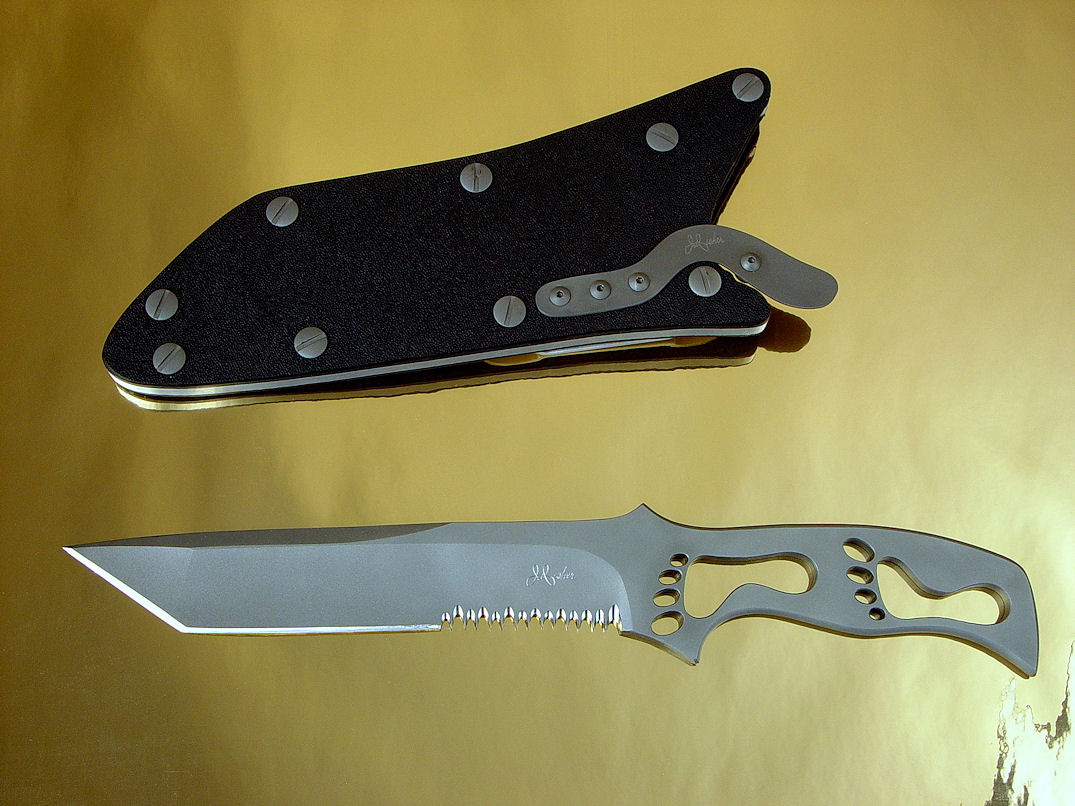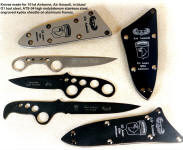Skeletonized Knives
 More
More about this PJSK Viper
Jay,
This is Jared Lay; my family has bought several knives from you. I bought my brother, Jeremiah Lay, a PJLT
Shank knife for him when he graduated the fire academy. Well, long story short, my brother uses the knife
all the time and just had it with him in the Philippines, after the destruction. He went into some areas
for rescue that were the first rescue people in. Just wanted you to know we love the knives you have
made and that they are doing great work across the world.
--Jared Lay
A skeleton is the bones forming the frame of a body, and in
skeletonized knives, there is only the frame. Usually, this refers to
only the handle, which does not typically have any fittings, bolsters,
guards, scales or other material attached. Skeletonized knives are
special knives, made this way for very specific reasons:
- Weight reduction: Light weight is the most
important reason to make a skeletonized knife. Because the knife
does not have handle material or fittings, the overall mass of the
knife can be reduced. This is important to specialized knife users,
such as military, survivalists, and law enforcement knife users who
must travel fast and light. By keeping the overall knife weight
down, other essentials can be packed, mounted, or carried. A
skeletonized knife is (and should be) about half the weight of a
similar-sized knife with full handle materials and fittings.
- Profile reduction: Thinness is important in
mounting and wearing a knife, and in certain cases, a thick handle
may be detrimental to mounting other equipment, and can possibly
restrict movement in tight areas, such as vehicles, aircraft,
shipboard, and maneuvering in tight places. The skeletonized knife
is thin, so does not protrude as much as handled knives, so there's
less chance of bumping into, hanging onto, or possibly snagging
equipment, machinery, and other people or personnel. With some
arrangements, skeletonized knives and sheaths can even be mounted
between the body and other gear or equipment, yet be easily
accessible.
- Exposures/Cleanliness: A skeletonized knife
typically has no other materials mounted or attached, so all areas
of the blade and handle can be easily seen, accessed, inspected and
cleaned. This may be critical in certain highly corrosive exposures
or continuous marine environments. In contact with possible
contaminants such as blood, fluids, and chemicals, the skeletonized
knife can then be completely immersion-cleaned, including even
autoclaving and sterilizing for disinfecting. All areas of the
blade, handle, and frame can be accessed, all can be inspected for
any signs of corrosion.
- Gas/Water Absorption: This one is not often
considered, but very important to hazardous materials exposures
responders and marine divers particularly. Most materials, even
manmade thermosets like phenolics and G10 composites can absorb
water, chemicals and gasses. This is because, although they appear
solid, plastics and other thermosets will have small voids, and many
of them are reinforced for toughness with canvas, paper, or
fiberglass cloth which contribute to more microscopic voids, pockets
or spaces. All of these materials can absorb water in prolonged
exposure, as well as gasses, particularly under higher pressures
such as that encountered on a dive. This may lead to swelling and
movement in the case of a dive knife, and contamination in the case
of a knife used in hazardous materials emergencies. By eliminating
the handle material altogether, as well as all attached devices and
features such as bolsters, guards, pommels and reinforcement, the
monolithic blade has no area for moisture or gasses to hide, and
thus no propensity for corrosion, swelling, loosening, or weakening
of the handle or mounting fixtures.
- Maneuverability: A narrow, light, and thin
knife can be more easily maneuvered in some places where space and
motion is limited. Since the skeletonized knife does not have a
bulky, wide, or long handle, it may be able to work in tight spots
that larger knives and handles can not reach.
- Cost/Expense: A skeletonized knife is typically
less expensive than a full tang knife with fittings and handle
material. This is because there is less material in the knife, but
more important, a lot less labor working with and making the full
handle material set. Though there may be significant labor in
complicated and detailed milling operations to reduce the handle
weight, balance the knife overall, and create an interesting and
useable handle design, this typically takes less time for the knife
maker than a full handle. The sheath is also thinner and lighter,
and this helps to make a less expensive knife.
- Delivery time: in our studio, the skeletonized
knife can deliver quicker than full handle models, because it
is faster to make. Each knife is handmade, and custom orders are
quoted individually.
From these reasons, you can see why a skeletonized knife may be the
type of knife needed. Here are some more skeletonized knives that I've
made over the years in several different forms:
Page Topics
Please click on thumbnail knife photos and links for more information

Shank

101st Airborne Knives

PJLT Shank

PJLT Shank

Creature

Shank
Just as with every type of knife, the skeletonized knife also has
limitations as well as advantages. Please remember that if there were one
universal, superior knife, all other knives would be discarded. Since this
is an impossibility, the choice of any knife type, style, pattern, material
set, and maker is based on the knife clients own specific needs. Some
important considerations about skeletonized knives are:
- Strength: this is probably the most important
concern for skeletonized knives to be considered by the knifemaker. Because
they have less material, less reinforcement, and less mass overall, they
are not as strong as a bolstered and handled knife. However, the knife
maker can do his best to increase the strength as much as possible by
using strong modern materials, using thick stock, properly hardening and
tempering the blade and handle, and designing the knife so that strength
between the handle and blade is substantial enough for use.
- Comfort: this is probably the most significant
detriment to skeletonized knives considered by the knife user, and it is
very important. Because the handles are thin by design, they can be
uncomfortable for continuous use, as there is less bearing surface along the edge of
the handle. These knives, consequently, are not recommended for
aggressive daily use. You can imagine a chef, for instance, gripping the
narrow handle of the skeletonized knife for hours a day, and it's easy
to see why this is not the application for this type of knife. Narrow
handles can also cause cramping and chafing, but gloves help and many
military clients who use these knives wear them. The knife maker can help
quite a bit with thse limitations by carefully radiusing, contouring,
rounding, and smoothing all of the exterior surfaces and edges of the
handle so that there are no sharp corners or angles for the hand to
contact. He can also use thicker stock (1/4", .025" or 6.4 mm or
thicker) to help prevent cramping. Width of the stock is important as
well, for narrow skeletonized handles can be small and uncomfortable.
Another critical step is to chamfer the cuts or milled holes through the
handle, so that there is no sharp corner that can chafe, abrade, or cut
the hand.
- Grip Certainty/Force Transfer: this is seldom considered or
discussed by people who make and sell so-called tactical knives, but it
should be. This is the ability to transfer great force from the handle
of the knife to the blade while keeping a secure grip. You can imagine
how much energy it takes to handle a knife in a combat situation, and
how a smaller, narrower handle may limit the grip strength necessary to
transfer that energy. A full, rounded handle with adequate reinforcement
in the quillon and bolster area will allow much more surface area to
contact the hand, thus more certain a grip can be maintained. Since it
is the handle shape (not the surface finish) that maintains grip
certainty, it is critical that the skeletonized knife is designed with
enough mass, width, and thickness to enable this energy transfer. This
is up to the knife maker and designer, depending on the expected use of
the knife. More about handle shape and grip certainty on my Tactical and
Combat Knives page
at this link.
Page Topics
 More
More about this Viper

Considering the advantages and limitations listed above, the choice of a skeletonized knife is up to the knife client.
If you think that the light weight, small profile, cleanliness, and low mass is the most important aspect of your knife choice, then
a skeletonized knife may be your best bet. Your custom knife maker should be able to work with you to make sure you are satisfied with
the knife, understand the advantages and limitations, and create a custom work that meets your needs.
In this studio,; you can rest assured that we will do just that. If
you are considering a skeletonized knife and do not see the exact form you
desire, please remember that we can design new skeletonized knives based on
the existing 400+ designs you can see on my
Custom Knife Patterns page, as well as create hybrid knife designs based
on the handle of one knife and the blade of another. We also work with new
designs continually and will be glad to consider your individual needs and
requirements.
Customization is another option for a skeletonized knife; we can cut or
mill any appropriate visual design through a knife handle or blade,
depending on the complexity and arrangement that will still support a strong
handle, blade, and junction. This is an exciting customization that can
include bold graphics, personal initials, and insignia of our clients.
Page Topics
 More
More about this Viper


